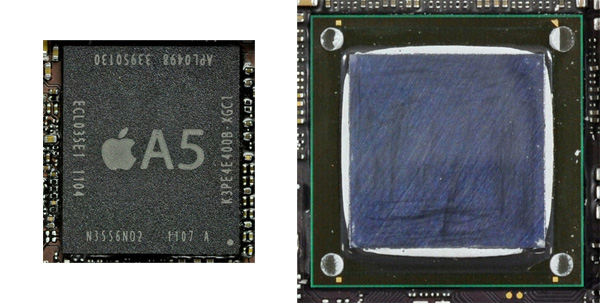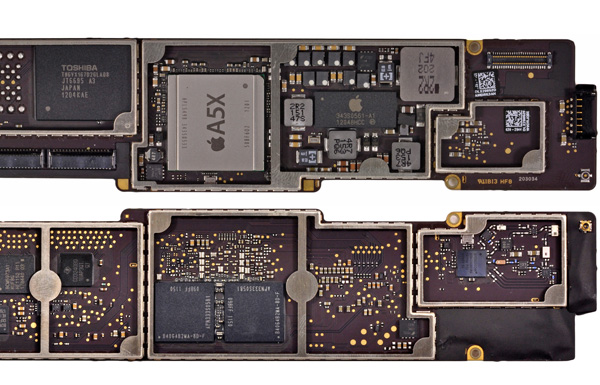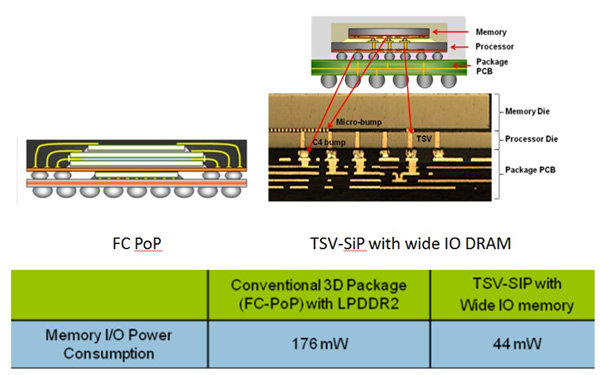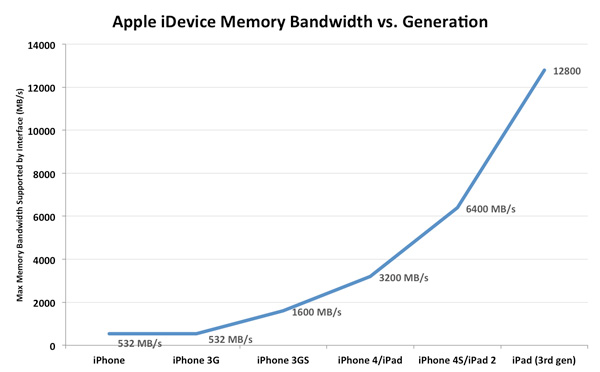The Apple iPad Review (2012)
by Vivek Gowri & Anand Lal Shimpi on March 28, 2012 3:14 PM ESTA Word on Packaging
Unlike the first two iPads, the 3rd generation iPad abandons the high density flip-chip PoP SoC/DRAM stack and uses a discrete, flip-chip BGA package for the SoC and two discrete BGA packages for the DRAMs.
If you think of SoC silicon as a stack, the lowest layer is where you'll find the actual transistor logic, while the layers of metal above it connect everything together. In the old days, the silicon stack would sit just as I've described it—logic at the bottom, metal layers on top. Pads around the perimeter of the top of the silicon would connect to very thin wires, that would then route to the package substrate and eventually out to balls or pins on the underside of the package. These wire bonded packages, as they were called, had lower limits of how many pins you could have connecting to your chip.
There are also cooling concerns. In a traditional wire bonded package, your cooling solution ultimately rests on a piece of your packaging substrate. The actual silicon itself isn't exposed.
As its name implies, a flip-chip package is literally the inverse of this. Instead of the metal layers being at the top of the stack, before packaging the silicon is inverted and the metal layers are at the bottom of the stack. Solder bumps at the top of the silicon stack (now flipped and at the bottom) connect the topmost metal layer to the package itself. Since we're dealing with solder bumps on the silicon itself rather than wires routed to the edge of the silicon, there's much more surface area for signals to get in/out of the silicon.
Since the chip is flipped, the active logic is now exposed in a flip-chip package and the hottest part of the silicon can be directly attached to a cooling solution.

An example of a PoP stack
To save on PCB real estate however, many SoC vendors would take a flip-chip SoC and stack DRAM on top of it in a package-on-package (PoP) configuration. Ultimately this re-introduces many of the problems from older packaging techniques—mainly it becomes difficult to have super wide memory interfaces as your ball-out for the PoP stack is limited to the area around your die, and cooling is a concern once more. For low power, low bandwidth mobile SoCs this hasn't really been a problem, which is why we see PoP stacks deployed all over the place.
Take a look at the A5, a traditional FC-BGA SoC with PoP DRAM vs. the A5X (this isn't to scale):

Images courtesy iFixit
The A5X in this case is a FC-BGA SoC but without any DRAM stacked on top of it. The A5X is instead covered in a thermally conductive paste and then with a metallic heatspreader to conduct heat away from the SoC and protect the silicon.
Given the size and complexity of the A5X SoC, it's no surprise that Apple didn't want to insulate the silicon with a stack of DRAM on top of it. In typical package-on-package stacks, you'd see solder bumps around the silicon, on the package itself, that a separate DRAM package would adhere to. Instead of building up a PoP stack here, Apple simply located its two 64-bit DRAM devices on the opposite side of the iPad's logic board and routed the four 32-bit LP-DDR2 memory channels through the PCB layers.

iPad (3rd gen) logic board back (top) and front (bottom), courtesy iFixit
If I'm seeing this correctly, it looks like the DRAM devices are shifted lower than the center point of the A5X. Routing high speed parallel interfaces isn't easy and getting the DRAM as close to the memory controller as possible makes a lot of sense. For years motherboard manufacturers and chipset vendors alike complained about the difficulties of routing a high-speed, 128-bit parallel DRAM interface on a (huge, by comparison) ATX motherboard. What Apple and its partners have achieved here is impressive when you consider that this type of interface only made it to PCs within the past decade.
Looking Forward: 12.8GB/s, the Magical Number
The DRAM speeds in the new iPad haven't changed. The -8D in the Elpida DRAM string tells us this memory is rated at the same 800MHz datarate as what's used in the iPhone 4S and iPad 2. With twice the number of channels to transfer data over however, the total available bandwidth (at least to the GPU) doubles. I brought back the graph I made for our iPhone 4S review to show just how things have improved:
The A5X's memory interface is capable of sending/receiving data at up to 12.8GB/s. While this is still no where near the 100GB/s+ we need for desktop quality graphics at Retina Display resolutions, it's absolutely insane for a mobile SoC. Bandwidth utilization is another story entirely—we have no idea how good Apple's memory controller is (it is designed in-house), but there's 4x the theoretical bandwidth available to the A5X as there is to NVIDIA's Tegra 3.
There's a ton of memory bandwidth here, but Apple got to this point by building a huge, very power hungry SoC. Too power hungry for use in a smartphone. As I mentioned at the start of this article, the SoC alone in the new iPad can consume more power than the entire iPhone 4S (e.g. A5X running Infinity Blade 2 vs. iPhone 4S loading a web page):
| Power Consumption Comparison | ||||
| Apple A5X (SoC + mem interface) | Apple iPhone 4S (entire device) | |||
| Estimated Power Consumption | 2.6W—Infinity Blade 2 | 1.6W—Web Page Loading | ||
There's no question that we need this much (and more) memory bandwidth, but the A5X's route to delivering it is too costly from a standpoint of power. There is a solution to this problem however: Wide IO DRAM.
Instead of using wires to connect DRAM to solder balls on a package that's then stacked on top of your SoC package, Wide IO DRAM uses through-silicon-vias (TSVs) to connect a DRAM die directly to the SoC die. It's an even more costly packaging technique, but the benefits are huge.

Just as we saw in our discussion of flip-chip vs. wire bonded packages, conventional PoP solutions have limits to how many IO pins you can have in the stack. If you can use the entire silicon surface for direct IO however, you can build some very wide interfaces. It also turns out that these through silicon interfaces are extremely power efficient.
The first Wide IO DRAM spec calls for a 512-bit, 200MHz SDR (single data rate) interface delivering an aggregate of 12.8GB/s of bandwidth. The bandwidth comes at much lower power consumption, while delivering all of the integration benefits of a traditional PoP stack. There are still cooling concerns, but for lower wattage chips they are less worrisome.
Intel originally predicted that by 2015 we'd see 3D die stacking using through-silicon-vias. Qualcomm's roadmaps project usage of TSVs by 2015 as well. The iPhone won't need this much bandwidth in its next generation thanks to a lower resolution display, but when the time comes, there will be a much lower power solution available thanks to Wide IO DRAM.
Oh and 2015 appears to be a very conservative estimate. I'm expecting to see the first Wide IO memory controllers implemented long before then...











234 Comments
View All Comments
PeteH - Tuesday, April 3, 2012 - link
I have to be honest, after reading through that link I didn't see anything that even implied working conditions had anything to do with the suicides of the factory workers. The only suicide for which there was any real information provided was that of the worker who killed himself after losing the iPhone prototype, and in that case the victim wasn't a factory worker, but someone in logistics.Did working conditions have anything to do with the factory worker suicides? Maybe, maybe not. There doesn't appear to be evidence either way.
mr_ripley - Wednesday, April 4, 2012 - link
I posted the Wikipedia link for all the links in the reference section.Here's a more direct report: http://sacom.hk/wp-content/uploads/2010/11/report-...
And a companion video: http://vimeo.com/17558439
The video includes an interview of a survivor who is now paralyzed waist down.
You can choose to patiently read and watch this report or just turn a blind eye like a lot of people do.
PeteH - Thursday, April 5, 2012 - link
I did read the report. It details unbelievably miserable working conditions in the factories, which I don't think anyone is disputing, and concludes that the way to change those conditions is to pressure the electronics companies making the bulk of the profits. None of the above comments dispute any of this. However it does not link working conditions to suicides among factory workers.And yet you continue to insist that there is a link, with no evidence to back it up. You make statements like, "over a hundred of them have committed suicide over the working conditions," "...scores of people killing themselves citing poor working conditions," and "there is no disputing the fact that these deaths are related to working conditions," but you provide only conjecture to back it up, no proof. When you do this people start dismissing everything you say out of hand, even the things that are accurate. And worse than that, you run the risk that other people arguing for better working conditions will be tarred with the same brush. Look at what happened to Mike Daisy.
Again, I'm not saying working conditions didn't contribute to the suicides, I'm saying there is no evidence one way or the other. Until you have evidence (in the form of suicide notes, higher suicide rates among factory workers, etc.) please stop. You may actually be hurting the very movement you're trying to help.
mr_ripley - Thursday, April 5, 2012 - link
Well, I'm sorry if it is inconvenient for you that these individuals have not said it in so many words. Should we expect them to?... Hey, by the way, I know you're going to kill yourself but why don't your write down an explanation first so we can conclusivly say what the reasons are. And even though you are under a lot of stress right now and are clearly not thinking straight SPELL it our for me please...Evidence can come in different forms. Not all of it is directly incriminating, in which case the attention turns to the circumstances. So if these reports don't establish a reasonbly clear coorelation to you, then I am sorry but I disagree.
You can nitpick on specific words in my comments and quible about words such as evidence. But what are you accomplishing here? Are you justifying your own guilt of purchasing a device manufactured here? Are you an Apple or Foxconn mouthpeice? Do they pay your for spreading lies like Foxconn factories are actually a good place to work (which has been said in the previous comments)? Really, it is people like you need to STOP.
I'm not going to stop saying what I believe is right!! And unlike Mike Daisy I have not fabricated any evidence. At the most, you can complain that I have drawn incorrect conclusions and I am saying the same about you.
PeteH - Thursday, April 5, 2012 - link
It's inconvenient for me that you are lying. You're the one saying that there are, "...scores of people killing themselves citing poor working conditions," not me. Either show me a case where those people who killed themselves cited poor working conditions as the reason, or cease claiming it is fact. You do damage to the movement that's trying to improve things.People hear the news reports about Mike Daisy lying to Ira Glass and what they take away is not the specific lies (claiming to witness things had actually happened but that he had only read about), it's that he's a liar and the story wasn't true. They dismiss the whole issue of poor working conditions out of hand. That's what you risk when you lie to get people to listen.
mr_ripley - Thursday, April 5, 2012 - link
Go ahead, nitpick on specific phrases and completely lose the meaning. But the problem is easily corrected. One can argue that citing something does not have to be done on paper as you would in a professional article. To me the workers "cite" the existence of a problem through their actions as words have failed them.Still if you want me to rephrase I'll say "scores of people killing themselves in midst of poor working conditions.." Can you prove that this statement is inaccurate??
And while you ask me for evidence have you ever bothered to see if you can find evidence that these deaths are not related to working conditions. Prove it to me and I'll take back everything I said.
PeteH - Thursday, April 5, 2012 - link
I think you missed the places above where I stated, "I'm not saying working conditions didn't contribute to the suicides, I'm saying there is no evidence one way or the other." That was my whole point. And I did explicitly state that there's no disputing the poor working conditions. So no, I have no problem with your revised statement.However, I don't think what I did was nitpicking at all. Nitpicking would be pointing out that a score is 20, so scores would imply at least 40, and I've only seen documentation of 17 suicides (I haven't seen numbers pre-2010). But that's not what I did.
shompa - Friday, March 30, 2012 - link
Manufacturing employees?Look at the world! There are about 20 countries in the world that are democratic and have great living standards. Its just 100 years ago since these countries had child workers and harsh condition.
BTW. My county is on the "top countries" in the world. Still we have the largest suicide rate in our population in the world. Why are you not fighting against the Swedish government that drives thousands to kill them self each year? We live like slaves here with 80% taxes.
BTW. Do you care if other companies use HonHai/FoxConn or is it just Apple? Are you writing the same thing about Dell/HP and all other companies that use FoxConn?
What have you done?
Have you donated money to a chinese worker? Or is Trolling the only thing you manage to do?
grave00 - Friday, March 30, 2012 - link
I was curious about this statement. Could you elaborate. What inconsistency is there?"On the iPhone Apple has been entirely too lax about maintaining consistency between suppliers. If it wants to be taken seriously in this space Apple needs to ensure a consistent experience across all of its component vendors."
loboracing - Friday, March 30, 2012 - link
I remember an ad that touted something new to "see and touch". The retina screen is the "see" part but what about the "touch"? Was that just a gimmick meaning you could touch the screen, or is there some sort of different feel to the screen?